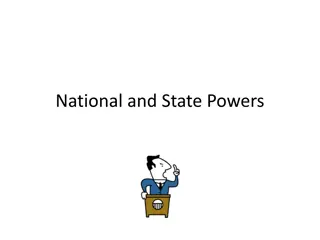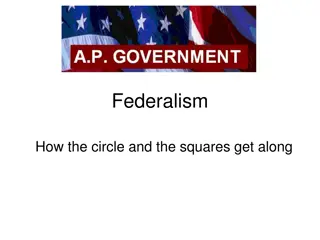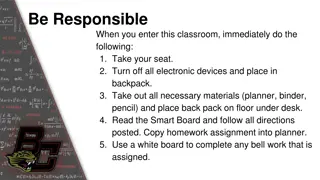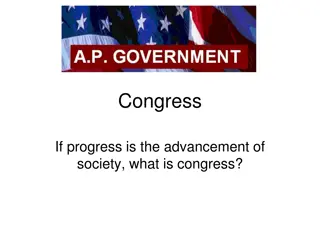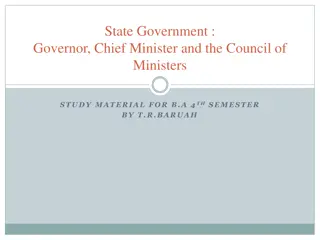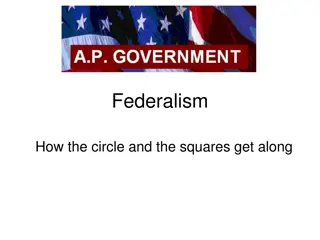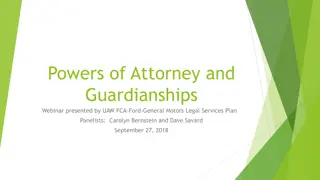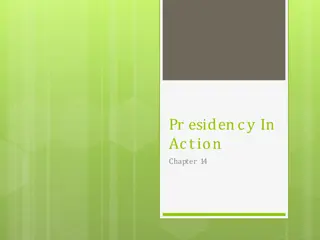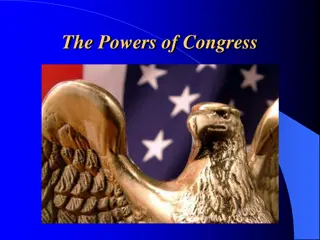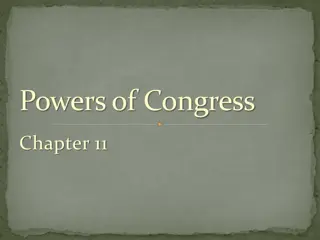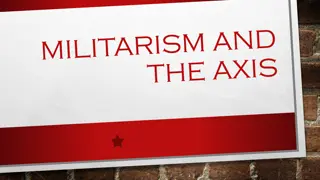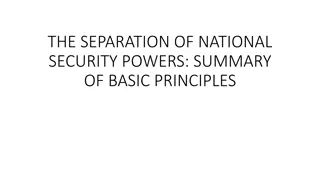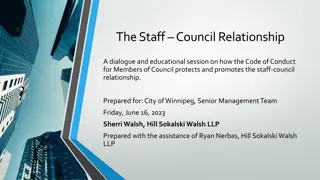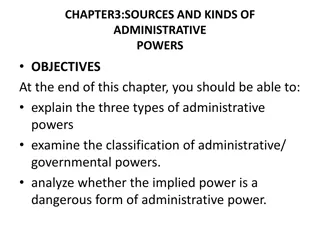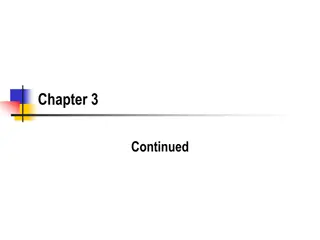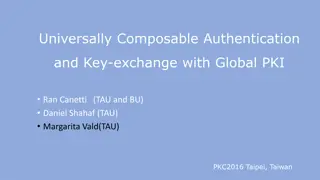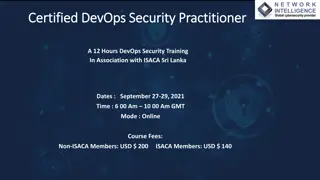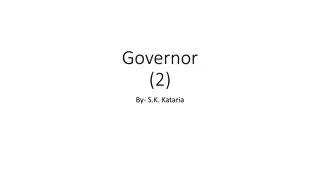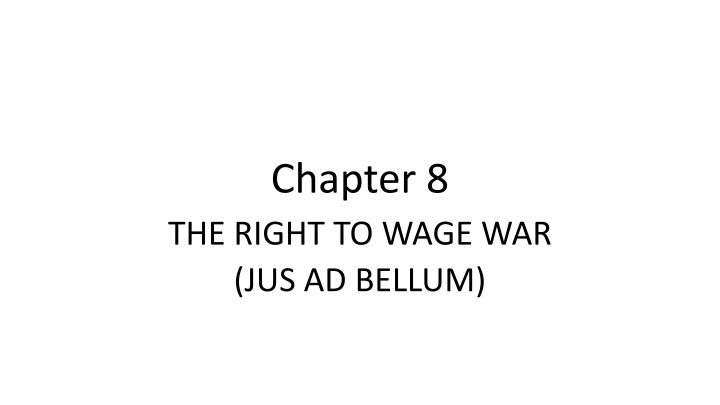
The UN Security Council: Key Roles and Powers
The United Nations Security Council plays a crucial role in maintaining international peace and security. Learn about its formation, permanent members, veto power, and decision-making processes. Explore the framework for sanctions and military intervention, as outlined in Article 39. Understand the historical context and significance of the Security Council to global affairs.
Download Presentation

Please find below an Image/Link to download the presentation.
The content on the website is provided AS IS for your information and personal use only. It may not be sold, licensed, or shared on other websites without obtaining consent from the author. If you encounter any issues during the download, it is possible that the publisher has removed the file from their server.
You are allowed to download the files provided on this website for personal or commercial use, subject to the condition that they are used lawfully. All files are the property of their respective owners.
The content on the website is provided AS IS for your information and personal use only. It may not be sold, licensed, or shared on other websites without obtaining consent from the author.
E N D
Presentation Transcript
Chapter 8 THE RIGHT TO WAGE WAR (JUS AD BELLUM)
Learning Objectives The UN Security Council holds the power of the UN. The UN and International Law constraints on waging war are important. They do not affect US law and thus we are only looking at them to get a sense of the structure of the UN and why it does not act as a legal constraint on US action. I am leaving the details of these to our public international law class.
The War to End All Wars (World War I) and the Formation of the UN The League of Nations was formed after WW I to prevent future wars. It did not work for many reasons, including the terms of the Treaty of Versailles, which obligated Germany to pay reparations for the damages caused by the war. The use of nuclear weapons by the US at the end of WWII strengthened the resolve of the major powers to form an international agency to reduce the chance of the next global conflict. The core purpose of the UN is to guarantee the sovereignty of the member nations against attack by other nations. The social programs are important but are divorced from this function. The power to protect sovereignty by force rests with the UN Security Counsel.
The UN Security Counsel The United States, the Soviet Union, and the United Kingdom were the winners of WWII and were logical permanent members of the Security Counsel. The US pushed the inclusion of China (Taiwan) and the UK pushed for the inclusion of France, as a buffer against Germany and the Soviet Union. Any permanent member can veto action by the Counsel. This was the key political compromise that underlies the UN. This is why the UN Security Counsel will never act against the US. In 1971, the UN General Assembly forced the substation of the PRC for Taiwan s seat on the Security Counsel. Had the PRC been on the security Counsel in 1950, the UN would not have authorized the defense of South Korea when it was invaded by the North in 1950. The permanent members are now the US, the UK/England, France, the PRC (China), and Russia. There are 10 elected member of the Security Counsel, but they do not have the veto and thus have little effect on Security Counsel policy.
The Framework for UN Security Council Sanctions and Military Intervention
ARTICLE 39 The Security Council shall determine the existence of any threat to the peace, breach of the peace, or act of aggression and shall make recommendations, or decide what measures shall be taken in accordance with Articles 41 and 42, to maintain and restore international peace and security. Access the situation
ARTICLE 40 In order to prevent an aggravation of the situation, the Security Council may, before making the recommendations or deciding upon the measures provided for in Article 39, call upon the parties concerned to comply with such provisional measures as it deems necessary or desirable. Such provisional measures shall be without prejudice to the rights, claims, or position of the parties concerned. The Security Council shall duly take account of failure to comply with such provisional measures. Ask for voluntary compliances with mitigation measures.
ARTICLE 41 The Security Council may decide what measures not involving the use of armed force are to be employed to give effect to its decisions, and it may call upon the Members of the United Nations to apply such measures. These may include complete or partial interruption of economic relations and of rail, sea, air, postal, telegraphic, radio, and other means of communication, and the severance of diplomatic relations. Impose non-military sanctions.
ARTICLE 42 Should the Security Council consider that measures provided for in Article 41 would be inadequate or have proved to be inadequate, it may take such action by air, sea, or land forces as may be necessary to maintain or restore international peace and security. Such actions may include demonstrations, blockade, and other operations by air, sea, or land forces of Members of the United Nations. Take military action
The First Gulf War (1991) Iraq occupies Kuwait. The State Department petitioned the UN Security Council to under 39 to access the situation. The Security Council found that Iraq had violated the sovereignty of Kuwait and warned Iraq to withdraw under 40. Iraq did not withdraw so and sanctions were applied under 41. When the sanctions failed, the Security Council authorized raising a military force under 42. When the forces had been assembled at the Iraq border, Iraq was given a last chance to withdraw from Kuwait. Iraq did not comply and the invasion was authorized by the Security Council under 42. When Iraq was pushed out of Kuwait, the mandate from the Security Council was exhausted and the Bush I ordered the military commander to demobilize and withdraw from Iraq.
ARTICLE 43 1. All Members of the United Nations, in order to contribute to the maintenance of international peace and security, undertake to make available to the Security Council, on its call and in accordance with a special agreement or agreements, armed forces, assistance, and facilities, including rights of passage, necessary for the purpose of maintaining international peace and security. 2. Such agreement or agreements shall govern the numbers and types of forces, their degree of readiness and general location, and the nature of the facilities and assistance to be provided. This would create a UN standing army. There is no support for this so it has never been implemented. Instead, troop are supplied as needed for specific missions authorized by the Security Council.
ARTICLE 51 Nothing in the present charter shall impair the inherent right of individual and collective self-defense if an armed attack occurs against a Member of the United Nations, until the Security Council has taken measures necessary to maintain international peace and security. . . . The UN Charter does not prohibit self-defense until the Security Council acts.
Effect of the Articles Any UN military or peace keeping actions requires the support of all permanent members of the Security Council. This effectively limits the Security Council to taking actions against unaligned nations those without the support of a major power for their aggression. The Charter of the UN itself limits actions to those that threaten the sovereignty of states through international conflict. There is no authority to intervene in civil wars unless they threaten neighboring countries. Since the UN authority is defined in terms of sovereign states, it is not clear that it has application to attacks by NGOs.
United Nations Participation Act 22 U.S.C. 287d. in Practical Terms The President controls the UN Ambassador who exercises the US vote on the Security Council. Thus, the UN Security Council will only take actions supported by the US president. The President can commit troops to UN actions within his foreign powers and commander in chief powers, consistent with Congressional limitations on funding. UN authority does not expand the President s authority.
ATS - Nestl USA, Inc. v. Doe, 141 S. Ct. 1931 (2021) (supp. Chap 7, p. 237) Plaintiffs claimed that the defendant aided and abetted the use of child slaves to harvest cocoa in the Ivory Coast. Nestl USA was alleged to have made key financial and operational decisions in the United States sufficient to provide the touch-and-concern nexus, although the child slavery took place entirely in the Ivory Coast. [A]llegations of general corporate activity like decisionmaking cannot alone establish domestic application of the ATS. . . . To plead facts sufficient to support a domestic application of the ATS, plaintiffs must allege more domestic conduct than general corporate activity. [If the plaintiffs can show more, they can likely get jurisdiction under ordinary US tort law.]
Where Must Plaintiffs look for Substantive Law when Using ATS Jurisdiction? But the statute on its own does not empower aliens to sue. We have been clear that the ATS is a jurisdictional statute creating no new causes of action. Sosa, 542 U. S., at 724. Aliens harmed by a violation of international law must rely on legislative and executive remedies, not judicial remedies, unless provided with an independent cause of action. In more than 200 years, Congress has established just one: the Torture Victim Protection Act of 1991. That Act creates a private right of action for victims of torture and extrajudicial killings in violation of international law. [Does Congress need the ATS to create new causes of action?]
What Did Sosa say are Potential Uses of the ATS? Sosa indicated that courts may exercise common-law authority under the ATS to create private rights of action in very limited circumstances. 542 U. S., at 724. Sosa suggested, for example, that courts could recognize causes of action for three historical violations of international law: violation of safe conducts, infringement of the rights of ambassadors, and piracy. But our precedents since Sosa have clarified that courts must refrain from creating a cause of action whenever there is even a single sound reason to defer to Congress. See, e.g., Hern ndez, 589 U. S., at ___ (slip op., at 8). Tellingly, we have never created a cause of action under the ATS. Even without reexamining Sosa, our existing precedents prohibit us from creating a cause of action here.
Is the ATS Frozen in Time like Bivens? Under existing precedent, then, courts in some circumstances might still apply Sosa to recognize causes of action for the three historical torts likely on the mind of the First Congress. But as to other torts, our precedents already make clear that there always is a sound reason to defer to Congress, so courts may not create a cause of action for those torts. Whether and to what extent defendants should be liable under the ATS for torts beyond the three historical torts identified in Sosa lies within the province of the Legislative Branch.
The Value and Limitations of Security Council Actions as a Matter of Law Security Council military and economic actions are valuable for dealing with regional conflicts by unaligned nations. These are usually small conflicts but included the Korean War and the Iran-Iraq War. These conflicts can be destabilizing and lead to broader conflicts involving major powers. The UN cannot deal with purely internal affairs, such as the Khmer Rouge killings in Cambodia or the killings in Rwanda. None of this is justiciable in US courts for the reasons we have seen in previous chapters.
The ICJ: Nicaragua v. United States of America This arose from the US support of an insurgency force the Contras - against the Nicaraguan government after the fall of Somoza. This is an International Court of Justice ruling, which has no force against the US because the US does not accept jurisdiction. The Court rejected the US mutual defense arguments because it did not find that Nicaragua had attacked any other country. It did find that US support for the Contras was effectively the same as the US attacking Nicaragua itself. The opinion raises many interesting issues about interplay between international law and the UN Charter. Ultimately, this has no effect on US law.
What have we learned about accountability for the US through the UN or the International Court of Justice? Do you think the it will be any easier to hold Russia or Russian nationals liable?
THE RIGHT TO WAGE WAR: SUMMARY OF BASIC PRINCIPLES Any threat or use of force in international relations must conform to the provisions of the United Nations Charter. Those provisions reflect and are influenced by a parallel body of customary international law norms, and vice versa. The U.N. Charter is generally regarded as not providing domestic authority for U.S. troop deployments. And since 1945, Congress has been reluctant to give open-ended approval for such deployments on United Nations missions.
The International Court of Justice may rule on the legality of armed conflicts when the states involved have submitted to the jurisdiction of the Court, and parties are bound to abide by its rulings, which may be enforced by the Security Council. Both the Charter and customary international law permit the use of force in only two circumstances: unilateral or collective self-defense in response to an armed attack, and collective action with the approval of the U.N. Security Council. But states have often used force in situations that do not strictly comply with these limits, suggesting an evolving flexibility in the rules.
Direct, substantial attacks by one states regular military forces against another state will violate the prohibition on the use of force. So will arming and training paramilitary forces to engage in civil strife in another state, if that support produces a sufficient measure of dependency and control. Financing of such forces alone, however, is not a violation. Force may be used in self-defense, in the absence of Security Council approval, only in response to an armed attack. If one state sends paramilitary forces into another state, it may be guilty of an armed attack if the scale and effects of the invasion are sufficiently great. But not if it merely furnishes weapons and other support to rebels there.
Legitimate uses of force in self-defense must be necessary (no time for deliberation and no reasonable alternative) and proportional (no nuclear weapons in response to a minor border incursion), and they may continue only until the U.N. Security Council has taken measures necessary to maintain international peace and security. States may not use coercion to intervene in matters that other sovereign states must be free to choose, including political, economic, social, and cultural systems, and the formulation of foreign policy. Whether intervention is permitted on purely humanitarian grounds is subject to vigorous current debate. Uses of force falling short of an armed attack may be met by proportionate countermeasures by the victim state, but collective armed responses are not permitted.



